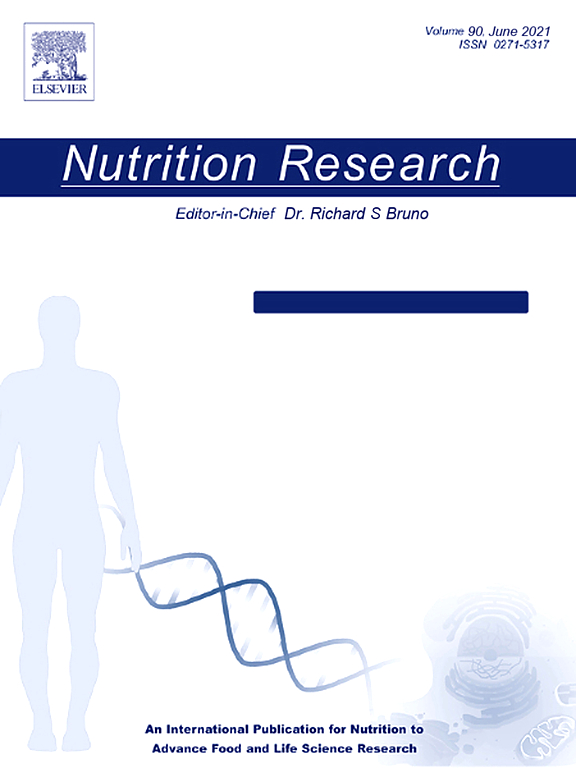营养状况改变了巴基斯坦白沙瓦阿富汗青少年难民的肠道菌群组成
IF 3.1
3区 医学
Q2 NUTRITION & DIETETICS
引用次数: 0
摘要
尽管人类肠道微生物组及其在健康和疾病中的作用已在不同人群中得到广泛研究,但尚未对弱势难民人群的肠道微生物组组成进行全面评估。在这项研究中,我们假设总体营养状况,如血清微量营养素浓度,是肠道微生物组组成变化的重要驱动因素。因此,对阿富汗青少年难民(n=206)的肠道微生物群多样性和相关的人口、健康和营养因素进行了评估。采集血液和粪便样本,分别进行营养状况标记和基于16S rRNA基因扩增子的群落分析。采用SPSS、QIIME和r软件进行生物信息学和统计学分析,共鉴定出56门117科252属。细菌多样性(α和β多样性)和厚壁菌门:拟杆菌门(F/B)比在15 ~ 19岁年龄组(10 ~ 14岁年龄组)显著较高,但在体重不足和维生素D缺乏组较低。此外,LEfSe分析发现,基于年龄、BMI和微量营养素(维生素和矿物质)状态的细菌属相对丰度存在显著差异。相关分析进一步证实,年龄、体重指数和微量营养素状况与F/B比和特定细菌类群的相对丰度存在显著相关性。总的来说,我们的研究首次表明,阿富汗青少年难民的肠道微生物群与一系列营养状况因素有关。因此,这些发现可以为旨在改善这些研究不足和脆弱人群的健康的转化微生物群研究提供基础。本文章由计算机程序翻译,如有差异,请以英文原文为准。

Nutritional status reshapes gut microbiota composition in adolescent Afghan refugees in Peshawar, Pakistan
Although the human gut microbiome, and its role in health and disease, have been extensively studied in different populations, a comprehensive assessment of gut microbiome composition has not been performed in vulnerable refugee populations. In this study, we hypothesized that overall nutritional status, as indicated by serum micronutrients concentrations, is an important driver of variations in gut microbiome composition. Therefore, gut-microbiome diversity and associated demographic, health and nutritional factors were assessed in adolescent Afghan refugees (n=206). Blood and faecal samples were collected and analysed for nutrition status markers and 16S rRNA gene amplicon-based community profiling, respectively. Bioinformatics and statistical analysis were performed using SPSS, QIIME and R. Overall, 56 distinct phyla, 117 families and 252 genera were identified in the faecal samples. Bacterial diversity (alpha and beta diversity) and the Firmicutes:Bacteroidetes (F/B) ratio were significantly higher in the 15 to 19 year old age group (cf. the 10-14 age group) but were lower in the underweight and vitamin D deficient groups. Furthermore, LEfSe analysis identified significant differences in the relative abundance of bacterial genera based on age, BMI and micronutrient (vitamins and minerals) status. These results were further scrutinised by correlation analysis which confirmed that age, BMI and micronutrient status show significant correlations with F/B ratio and the relative abundance of specific bacterial taxa. Collectively, our study provides the first indication of how the gut-microbiota profile of adolescent Afghan refugees is associated with a range of nutrition-status factors. These findings can thus provide a basis for translational microbiota research aimed at improving the health of such understudied and vulnerable populations.
求助全文
通过发布文献求助,成功后即可免费获取论文全文。
去求助
来源期刊

Nutrition Research
医学-营养学
CiteScore
7.60
自引率
2.20%
发文量
107
审稿时长
58 days
期刊介绍:
Nutrition Research publishes original research articles, communications, and reviews on basic and applied nutrition. The mission of Nutrition Research is to serve as the journal for global communication of nutrition and life sciences research on diet and health. The field of nutrition sciences includes, but is not limited to, the study of nutrients during growth, reproduction, aging, health, and disease.
Articles covering basic and applied research on all aspects of nutrition sciences are encouraged, including: nutritional biochemistry and metabolism; metabolomics, nutrient gene interactions; nutrient requirements for health; nutrition and disease; digestion and absorption; nutritional anthropology; epidemiology; the influence of socioeconomic and cultural factors on nutrition of the individual and the community; the impact of nutrient intake on disease response and behavior; the consequences of nutritional deficiency on growth and development, endocrine and nervous systems, and immunity; nutrition and gut microbiota; food intolerance and allergy; nutrient drug interactions; nutrition and aging; nutrition and cancer; obesity; diabetes; and intervention programs.
 求助内容:
求助内容: 应助结果提醒方式:
应助结果提醒方式:


